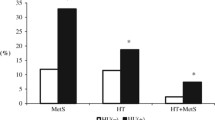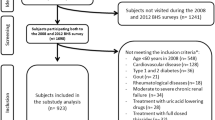Abstract
Serum levels of uric acid (UA) are associated with metabolic syndrome (MetS). However, no study has been aimed to investigate whether baseline UA is a predictor of MetS in a Japanese population. The multivariable adjusted hazard ratios (HRs) of MetS through 3 years were calculated for each 1 SD increase in baseline UA, for the higher quartiles of baseline UA compared with the lowest quartile, and for baseline hyperuricemia defined as ≥7.0 mg/dl for men and ≥6.0 mg/dl for women in apparently healthy 1,606 men aged 51.7 ± 9.4 years and 953 women aged 51.6 ± 9.4 years who visited a medical check-up center in Japan. The HRs (95 % confidence interval; p value) were 1.282 (1.097–1.499; 0.002) in men and 1.354 (1.041–1.762; 0.024) in women for 1 SD increase in baseline UA, 2.206 (1.344–3.620; 0.002) in men and 3.110 (1.121–8.627; 0.029) in women for the highest quartile of baseline UA compared with the lowest quartile, and 1.900 (1.376–2.622; <0.001) in men and 2.088 (1.040–4.190; 0.038) in women for baseline hyperuricemia adjusting for the pre-existing components of MetS, age, smoking, drinking, physical activity, use of antihypertensive, antihyperlipidemic, and antidiabetic medications and histories of coronary heart disease and stroke. However, no significant association was found between longitudinal changes in UA and incident MetS. Baseline UA is an independent predictor of MetS in a Japanese health screening population.

Similar content being viewed by others
References
Davis N (1897) The cardiovascular and renal relations and manifestations of gout. JAMA 29:261–262
Gertler MM, Garn SM, Levine SA (1951) Serum uric acid in relation to age and physique in health and in coronary heart disease. Ann Intern Med 34:1421–1431
Cannon PJ, Stason WB, Demartini FE, Sommers SC, Laragh JH (1966) Hyperuricemia in primary and renal hypertension. N Engl J Med 275:457–464
Lehto S, Niskanen L, Rönnemaa T, Laakso M (1998) Serum uric acid is a strong predictor of stroke in patients with non-insulin-dependent diabetes mellitus. Stroke 29:635–639
Tuttle KR, Short RA, Johnson RJ (2001) Sex differences in uric acid and risk factors for coronary artery disease. Am J Cardiol 87:1411–1414
Feig DI, Johnson RJ (2003) Hyperuricemia in childhood primary hypertension. Hypertension 42:247–252
Siu YP, Leung KT, Tong MK, Kwan TH (2006) Use of allopurinol in slowing the progression of renal disease through its ability to lower serum uric acid level. Am J Kidney Dis 47:51–59
Talaat KM, el-Sheikh AR (2007) The effect of mild hyperuricemia on urinary transforming growth factor beta and the progression of chronic kidney disease. Am J Nephrol 27:435–440
Ford ES, Li C, Cook S, Choi HK (2007) Serum concentrations of uric acid and the metabolic syndrome among US children and adolescents. Circulation 115:2526–2532
Nakagawa T, Tuttle KR, Short RA, Johnson RJ (2005) Fructose-induced hyperuricemia as a casual mechanism for the epidemic of the metabolic syndrome. Nat Clin Pract Nephrol 1:80–86
Culleton BF, Larson MG, Kannel WB, Levy D (1999) Serum uric acid and risk for cardiovascular disease and death: the Framingham Heart Study. Ann Intern Med 131:7–13
Chobanian AV, Bakris GL, Black HR, Cushman WC, Green LA, Izzo JL Jr, Jones DW, Materson BJ, Oparil S, Wright JT Jr, Roccella EJ, National Heart, Lung, and Blood Institute Joint National Committee on Prevention, Detection, Evaluation, and Treatment of High Blood Pressure, National High Blood Pressure Education Program Coordinating Committee (2003) The Seventh Report of the Joint National Committee on Prevention, Detection, Evaluation, and Treatment of High Blood Pressure: the JNC 7 report. JAMA 289:2560–2572
Pearson TA, Blair SN, Daniels SR, Eckel RH, Fair JM, Fortmann SP, Franklin BA, Goldstein LB, Greenland P, Grundy SM, Hong Y, Miller NH, Lauer RM, Ockene IS, Sacco RL, Sallis JF Jr, Smith SC Jr, Stone NJ, Taubert KA (2002) AHA guidelines for primary prevention of cardiovascular disease and stroke: 2002 update: consensus panel guide to comprehensive risk reduction for adult patients without coronary or other atherosclerotic vascular diseases. Circulation 106:388–391
Niskanen LK, Laaksonen DE, Nyyssönen K, Alfthan G, Lakka HM, Lakka TA, Salonen JT (2004) Uric acid level as a risk factor for cardiovascular and all-cause mortality in middle-aged men: a prospective cohort study. Arch Intern Med 164:1546–1551
Fang J, Alderman MH (2000) Serum uric acid and cardiovascular mortality: the NHANES I epidemiologic follow-up study, 1971–1992. JAMA 283:2404–2410
Alderman MH, Cohen H, Madhavan S, Kivlighn S (1999) Serum uric acid and cardiovascular events in successfully treated hypertensive patients. Hypertension 34:144–150
Niskanen L, Laaksonen DE, Lindström J, Eriksson JG, Keinänen-Kiukaanniemi S, Ilanne-Parikka P, Aunola S, Hämäläinen H, Tuomilehto J, Uusitupa M (2006) Serum uric acid as a harbinger of metabolic outcome in subjects with impaired glucose tolerance: the Finnish Diabetes Prevention Study. Diabetes Care 29:709–711
Iseki K, Ikemiya Y, Inoue T, Iseki C, Kinjo K, Takishita S (2004) Significance of hyperuricemia as a risk factor for developing ESRD in a screened cohort. Am J Kidney Dis 44:642–650
Iseki K, Oshiro S, Tozawa M, Iseki C, Ikemiya Y, Takishita S (2001) Significance of hyperuricemia on the early detection of renal failure in a cohort of screened subjects. Hypertens Res 24:691–697
Tomita M, Mizuno S, Yamanaka H, Hosoda Y, Sakuma K, Matuoka Y, Odaka M, Yamaguchi M, Yosida H, Morisawa H, Murayama T (2000) Does hyperuricemia affect mortality? A prospective cohort study of Japanese male workers. J Epidemiol 10:403–409
Alper AB Jr, Chen W, Yau L, Srinivasan SR, Berenson GS, Hamm LL (2005) Childhood uric acid predicts adult blood pressure: the Bogalusa Heart Study. Hypertension 45:34–38
Forman JP, Choi H, Curhan GC (2007) Plasma uric acid level and risk for incident hypertension among men. J Am Soc Nephrol 18:287–292
Krishnan E, Kwoh CK, Schumacher HR, Kuller L (2007) Hyperuricemia and incidence of hypertension among men without metabolic syndrome. Hypertension 49:298–303
Masuo K, Kawaguchi H, Mikami H, Ogihara T, Tuck ML (2003) Serum uric acid and plasma norepinephrine concentrations predict subsequent weight gain and blood pressure elevation. Hypertension 42:474–480
Mellen PB, Bleyer AJ, Erlinger TP, Evans GW, Nieto FJ, Wagenknecht LE, Wofford MR, Herrington DM (2006) Serum uric acid predicts incident hypertension in a biethnic cohort: the Atherosclerosis Risk in Communities study. Hypertension 48:1037–1042
Nagahama K, Inoue T, Iseki K, Touma T, Kinjo K, Ohya Y, Takishita S (2004) Hyperuricemia as a predictor of hypertension in a screened cohort in Okinawa, Japan. Hypertens Res 27:835–841
Nakanishi N, Okamoto M, Yoshida H, Matsuo Y, Suzuki K, Tatara K (2003) Serum uric acid and risk for development of hypertension and impaired fasting glucose or Type II diabetes in Japanese male office workers. Eur J Epidemiol 18:523–530
Perlstein TS, Gumieniak O, Williams GH, Sparrow D, Vokonas PS, Gaziano M, Weiss ST, Litonjua AA (2006) Uric acid and the development of hypertension: the Normative Aging Study. Hypertension 48:1031–1036
Sundström J, Sullivan L, D’Agostino RB, Levy D, Kannel WB, Vasan RS (2005) Relations of serum uric acid to longitudinal blood pressure tracking and hypertension incidence. Hypertension 45:28–33
Taniguchi Y, Hayashi T, Tsumura K, Endo G, Fujii S, Okada K (2001) Serum uric acid and the risk for hypertension and Type 2 diabetes in Japanese men: the Osaka Health Survey. J Hypertens 19:1209–1215
Dehghan A, van Hoek M, Sijbrands EJ, Hofman A, Witteman JC (2008) High serum uric acid as a novel risk factor for type 2 diabetes. Diabetes Care 31:361–362
Quiñones Galvan A, Natali A, Baldi S, Frascerra S, Sanna G, Ciociaro D, Ferrannini E (1995) Effect of insulin on uric acid excretion in humans. Am J Physiol 268:E1–E5
Carnethon MR, Fortmann SP, Palaniappan L, Duncan BB, Schmidt MI, Chambless LE (2003) Risk factors for progression to incident hyperinsulinemia: the Atherosclerosis Risk in Communities Study, 1987–1998. Am J Epidemiol 158:1058–1067
Chien KL, Chen MF, Hsu HC, Chang WT, Su TC, Lee YT, Hu FB (2008) Plasma uric acid and the risk of type 2 diabetes in a Chinese community. Clin Chem 54:310–316
Nakagawa T, Hu H, Zharikov S, Tuttle KR, Short RA, Glushakova O, Ouyang X, Feig DI, Block ER, Herrera-Acosta J, Patel JM, Johnson RJ (2006) A causal role for uric acid in fructose-induced metabolic syndrome. Am J Physiol Renal Physiol 290:F625–F631
Sánchez-Lozada LG, Tapia E, Bautista-García P, Soto V, Avila-Casado C, Vega-Campos IP, Nakagawa T, Zhao L, Franco M, Johnson RJ (2008) Effects of febuxostat on metabolic and renal alterations in rats with fructose-induced metabolic syndrome. Am J Physiol Renal Physiol 294:F710–F718
Reungjui S, Roncal CA, Mu W, Srinivas TR, Sirivongs D, Johnson RJ, Nakagawa T (2007) Thiazide diuretics exacerbate fructose-induced metabolic syndrome. J Am Soc Nephrol 18:2724–2731
Onat A, Uyarel H, Hergenç G, Karabulut A, Albayrak S, Sari I, Yazici M, Keleş I (2006) Serum uric acid is a determinant of metabolic syndrome in a population-based study. Am J Hypertens 19:1055–1062
Lohsoonthorn V, Dhanamun B, Williams MA (2006) Prevalence of hyperuricemia and its relationship with metabolic syndrome in Thai adults receiving annual health exams. Arch Med Res 37:883–889
Choi HK, Ford ES (2007) Prevalence of the metabolic syndrome in individuals with hyperuricemia. Am J Med 120:442–447
Liu PW, Chang TY, Chen JD (2010) Serum uric acid and metabolic syndrome in Taiwanese adults. Metabolism 59:802–807
Ryu S, Song J, Choi BY, Lee SJ, Kim WS, Chang Y, Kim DI, Suh BS, Sung KC (2007) Incidence and risk factors for metabolic syndrome in Korean male workers, ages 30–39. Ann Epidemiol 17:245–252
Sui X, Church TS, Meriwether RA, Lobelo F, Blair SN (2008) Uric acid and the development of metabolic syndrome in women and men. Metabolism 57:845–852
Gonçalves JP, Oliveira A, Severo M, Santos AC, Lopes C (2012) Cross-sectional and longitudinal associations between serum uric acid and metabolic syndrome. Endocrine 41:450–457
Yang T, Chu CH, Bai CH, You SL, Chou YC, Chou WY, Chien KL, Hwang LC, Su TC, Tseng CH, Sun CA (2012) Uric acid level as a risk marker for metabolic syndrome: a Chinese cohort study. Atherosclerosis 220:525–531
Grundy SM, Cleeman JI, Daniels SR, Donato KA, Eckel RH, Franklin BA, Gordon DJ, Krauss RM, Savage PJ, Smith SC Jr, Spertus JA, Costa F, American Heart Association, National Heart, Lung, and Blood Institute (2005) Diagnosis and management of the metabolic syndrome: a statement for health care professionals: an American Heart Association/National Heart, Lung, and Blood Institute Scientific Statement. Circulation 112:2735–2752
Alberti KGMM, Eckel RH, Grundy SM, Zimmet PZ, Cleeman JI, Donato KA, Fruchart JC, James WP, Loria CM, Smith SC Jr, International Diabetes Federation Task Force on Epidemiology and Prevention, National Heart, Lung, and Blood Institute, American Heart Association, World Heart Federation, International Atherosclerosis Society, International Association for the Study of Obesity (2009) Harmonizing the metabolic syndrome. A joint interim statement of the International Diabetes Federation Task Force on Epidemiology and Prevention; National Heart, Lung, and Blood Institute; American Heart Association; World Heart Federation; International Atherosclerosis Society; and International Association for the Study of Obesity. Circulation 120:1640–1645
Alberti KGMM, Zimmet P, Shaw J (2006) Metabolic syndrome—a new world-wide definition. A consensus statement from the International Diabetes Federation. Diabet Med 223:469–480
Oda E (2012) Metabolic syndrome: its history, mechanisms, and limitations. Acta Diabetol 49:89–95
Choi HK, Ford ES (2007) Prevalence of the metabolic syndrome in individuals with hyperuricemia. Am J Med 120:442–447
Saito T, Mochizuki T, Uchida K, Tsuchiya K, Nitta K (2012) Metabolic syndrome and risk of progression of chronic kidney disease: a single-center cohort study in Japan. Heart Vessels. doi:10.1007/s00380-012-0254-5
Nishino M, Mori N, Yoshimura T, Nakamura D, Lee Y, Taniike M, Makino N, Kato H, Egami Y, Shutta R, Tanouchi J, Yamada Y (2013) Higher serum uric acid and lipoprotein(a) are correlated with coronary spasm. Heart Vessels. doi:10.1007/s00380-013-0346-x
Acknowledgments
The author thanks all subjects who participated in the study, the paramedical staff at our center who assisted with the study, and Honorary Prof. Yoshifusa Aizawa at Tachikawa Medical Center for his instructive comments. The author received no financial support for this study and has no conflict of interest to disclose.
Author information
Authors and Affiliations
Corresponding author
Rights and permissions
About this article
Cite this article
Oda, E. Serum uric acid is an independent predictor of metabolic syndrome in a Japanese health screening population. Heart Vessels 29, 496–503 (2014). https://doi.org/10.1007/s00380-013-0386-2
Received:
Accepted:
Published:
Issue Date:
DOI: https://doi.org/10.1007/s00380-013-0386-2




